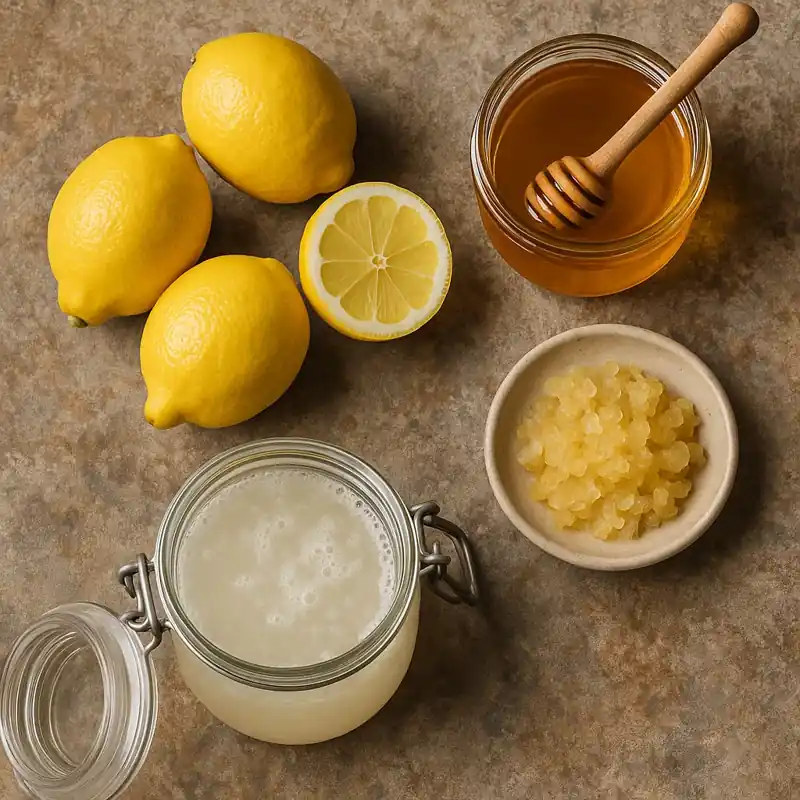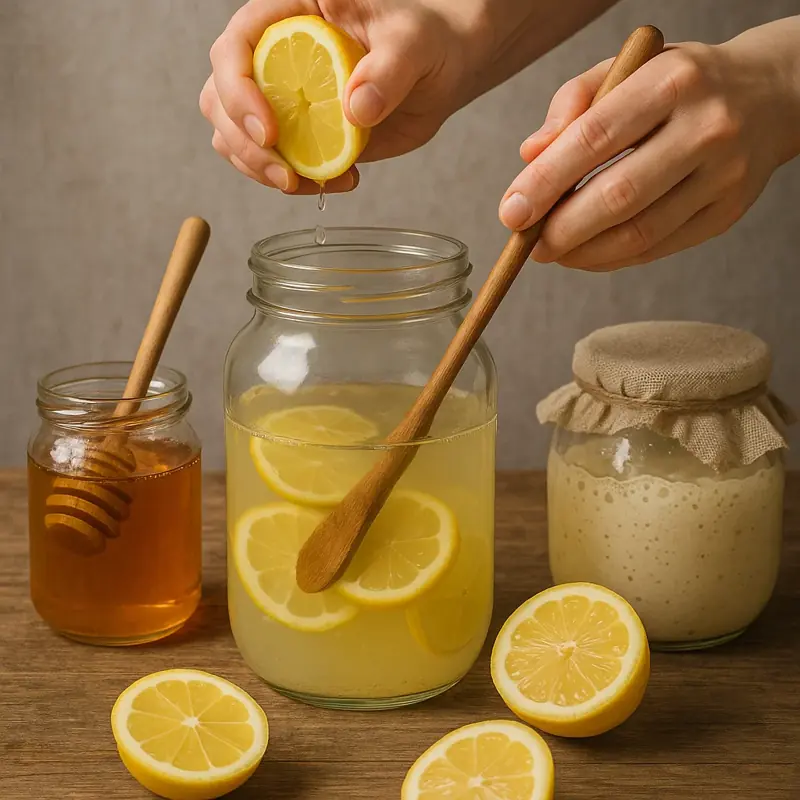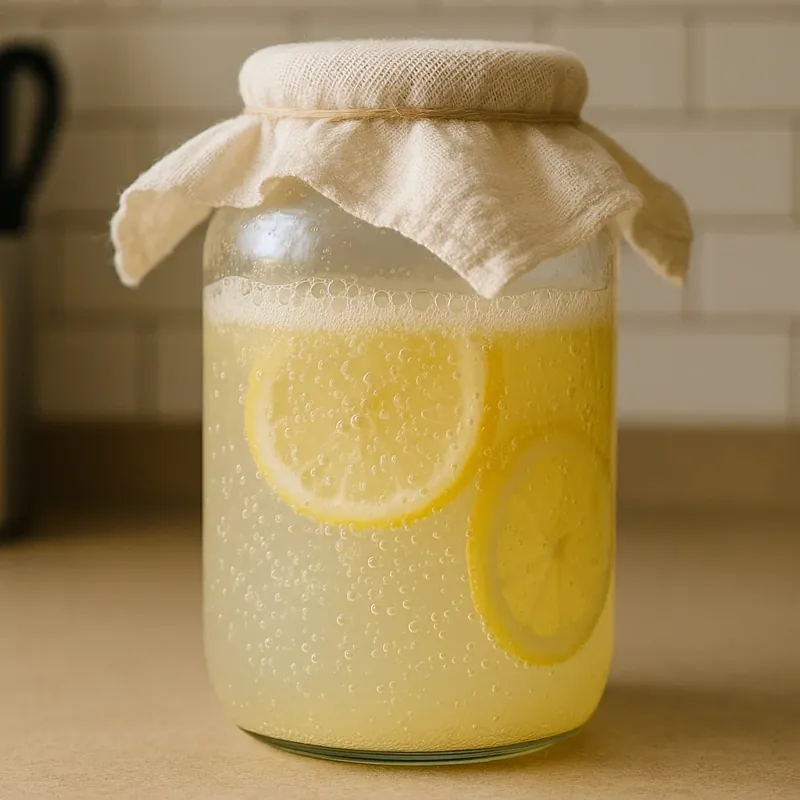Growing up, lemonade was always more than just a drink it was the centerpiece of family gatherings. I still remember long afternoons when my mom would bring out a big pitcher of homemade lemonade, ice clinking against the glass, while everyone gathered around the table. When I moved to New Mexico for work, far from those family traditions, I wanted to recreate that same feeling of connection. That’s when I stumbled upon fermented drinks, and eventually, the postbiotic lemonade recipe. It combined everything I loved about the original fresh citrus, sweetness, and thirst-quenching flavor with a health boost that fit perfectly into my lifestyle.
These days, making a postbiotic lemonade recipe feels like my way of blending tradition with wellness. Every time I pour a glass, I get that same sense of comfort and nostalgia, but with the added benefit of knowing I’m supporting my gut health. If you’re someone who enjoys trying new homemade drinks or looking for healthy recipes, this recipe belongs in your kitchen rotation.
What Makes Postbiotic Lemonade Special
So, what exactly sets this lemonade apart from the regular pitcher you might already know? It’s all about the fermentation process. When lemon juice, water, and a natural starter culture are combined, they undergo fermentation. Probiotics do the initial work, and what’s left behind are postbiotics the beneficial byproducts that nourish your gut in a safe, mild way. Unlike kombucha or other stronger fermented drinks, this postbiotic lemonade recipe is gentle, lightly fizzy, and refreshingly tart without being overwhelming.
That’s why it has become one of my favorite recipes to share. It’s easy to make, naturally flavorful, and a fun way to bring wellness into something as simple as lemonade. Whether you’re curious about gut-friendly drinks or just love experimenting in the kitchen, this recipe is a great place to start.
Table Of Content
Table of Contents

Postbiotic Lemonade Recipe – Refreshing & Proven Gut Drink
- Total Time: 24–48 hours
- Yield: 8 servings 1x
- Diet: Gluten Free
Description
A refreshing and gut-friendly postbiotic lemonade recipe made with lemons, honey, and natural fermentation for a fizzy, tangy drink.
Ingredients
6 large fresh lemons
6 cups filtered water
½ cup raw honey or sugar
3 tbsp whey, ginger bug, or probiotic starter
1 large glass jar with lid
Instructions
Juice lemons into a clean glass jar.
Add filtered water and stir in raw honey until dissolved.
Add starter culture and stir gently.
Cover loosely and ferment at room temperature for 24–48 hours.
Taste test after 24 hours, strain, and refrigerate in sealed bottles.
Notes
Ferment up to 48 hours for stronger fizz.
Store refrigerated for up to 2 weeks.
Discard if smell or appearance seems off.
- Prep Time: 10 minutes
- Category: Drinks
- Method: Fermentation
- Cuisine: Homemade
Nutrition
- Serving Size: 1 cup
- Calories: 70
- Sugar: 12g
- Sodium: 5mg
- Fat: 0g
- Saturated Fat: 0g
- Unsaturated Fat: 0g
- Trans Fat: 0g
- Carbohydrates: 18g
- Fiber: 1g
- Protein: 1g
- Cholesterol: 0mg
Keywords: postbiotic lemonade recipe, fermented lemonade, probiotic drinks
Benefits & Science Behind Fermented Lemonade
Why Gut Health Loves This Drink
One of the best reasons to try a postbiotic lemonade recipe is the way it supports gut health. During fermentation, the natural sugars in honey or another sweetener are broken down by probiotics. Once that process finishes, what’s left are postbiotics compounds like short-chain fatty acids, peptides, and enzymes that can help the digestive system work more smoothly. Drinking probiotic and postbiotic beverages regularly has been linked to better nutrient absorption, improved digestion, and even stronger immune support.
Unlike supplements, this is wellness in its most enjoyable form. You don’t have to think about capsules or powders you just pour yourself a glass of something refreshing. And because this postbiotic lemonade recipe is naturally hydrating and rich in vitamin C from fresh lemons, you get double the benefit: gut support plus antioxidant protection. If you’ve been curious about fermented foods but want something simple to start with, a glass of homemade fermented drinks like this is the perfect first step.
Flavor, Refreshment, and Everyday Use
Beyond health perks, this postbiotic lemonade recipe stands out for its taste. It balances tangy citrus with a gentle fizz, making it far more interesting than plain water yet not as strong as kombucha or kefir. The flavor feels crisp and bright, perfect for cooling down on a hot day or pairing with a light meal. Imagine serving it alongside grilled vegetables, a fresh salad, or one of your favorite summer recipes.
Another advantage is how versatile it is. You can sip it in the afternoon for a pick-me-up, serve it at gatherings as a unique homemade drink, or keep a bottle in the fridge for quick hydration. Since it’s low in sugar compared to store-bought sodas and juices, it’s a smart option for anyone trying to cut back without missing out on something fun to drink. Every pour delivers both refreshment and function, which is what makes it such a staple in my kitchen.
Step-by-Step Postbiotic Lemonade Recipe
Ingredients You’ll Need

Making a postbiotic lemonade recipe doesn’t require anything fancy you’ll find most of the ingredients in your kitchen already. The key is using fresh lemons and a natural starter to kick off fermentation. Here’s what you’ll need
- 6 large fresh lemons (organic, if possible)
- 6 cups filtered water
- ½ cup raw honey (or cane sugar)
- 3 tablespoons whey, ginger bug, or a probiotic starter culture
- A large glass jar with a lid
The honey feeds the beneficial bacteria during fermentation, while the starter introduces live cultures to begin the process. Lemons bring not only vibrant flavor but also vitamin C and antioxidants. Once you gather everything, you’re ready to start creating your own batch. If you’ve enjoyed making homemade condiments or other DIY mixes, you’ll love how simple this postbiotic lemonade recipe feels.
How to Ferment Lemonade Safely
- Juice the lemons into a clean jar, then add the filtered water and honey. Stir until the honey is dissolved.
- Add the starter culture (whey or ginger bug) and stir gently.

3- Cover the jar loosely with a lid or cloth. Leave it at room temperature, away from direct sunlight, for 24–48 hours.
4- Taste test after 24 hours. If it tastes tangy and lightly fizzy, it’s ready. If you want more fizz, let it ferment another day.

5- Strain and refrigerate. Once fermented, strain into bottles with tight lids to capture carbonation. Store in the fridge for up to two weeks.$
This postbiotic lemonade recipe is one of the easiest ways to explore fermentation at home. It takes minimal effort, and the reward is a refreshing, gut-friendly drink you’ll actually look forward to sipping.
Storing & Serving Postbiotic Lemonade

How Long Does Fermented Lemonade Last?
Once your postbiotic lemonade recipe has finished fermenting, proper storage is the key to keeping both flavor and fizz. After straining the liquid into airtight bottles, place them in the refrigerator. The cold slows fermentation, preserving the drink for up to two weeks. If you enjoy a sparkling touch, swing-top bottles help trap natural carbonation. Over time, the taste becomes slightly more complex, but it should always remain crisp and refreshing. If you notice an off smell or unusual appearance, it’s best to discard and start fresh. Just like other make-ahead recipes, the trick is keeping it chilled and sealed.
Serving Ideas & Variations
The beauty of a postbiotic lemonade recipe is how flexible it is at the table. For a classic approach, pour it over ice and garnish with lemon wedges or fresh mint. To mix things up, try muddling berries or adding cucumber slices before serving. If you’re preparing it for kids, stop fermentation at the 24-hour mark for a lighter flavor. Adults can let it ferment longer for a tangier, more bubbly experience. Another fun option is blending it with sparkling water for a festive twist. Pair this postbiotic lemonade recipe with family favorites at dinner or serve it as a refreshing alternative to soda at gatherings.
Feel free to experiment with herbs like basil, ginger slices, or lavender during fermentation. Each variation enhances the bright citrus flavor while offering something new to enjoy. No matter how you serve it, this drink is both gut-friendly and delicious, proving that a simple recipe can easily become a household favorite.
FAQs About Postbiotic Lemonade
How to make probiotic lemon?
To make probiotic lemon, you combine lemon juice, water, a natural sweetener, and a starter culture like whey or ginger bug. The mixture ferments at room temperature for 24–48 hours. This process transforms regular lemonade into a probiotic-rich drink. A postbiotic lemonade recipe takes it a step further by highlighting the beneficial compounds left behind after fermentation, making it both refreshing and gut-friendly.
Is probiotic lemonade good for you?
Yes, probiotic lemonade is good for you because it supports digestion, hydration, and overall gut health. The fermentation process produces beneficial bacteria and postbiotics, while lemons provide vitamin C and antioxidants. A well-made postbiotic lemonade recipe offers a gentle way to enjoy those benefits in a drink that’s both tasty and functional.
Is it okay to drink fermented lemonade?
It is safe to drink fermented lemonade when prepared properly. Fermentation creates natural fizz and tang without harmful effects if the ingredients are fresh and the jars are clean. If the lemonade smells off or looks cloudy, discard it and make a new batch. Following a tested postbiotic lemonade recipe ensures both safety and flavor.
How long does fermented lemonade last?
Fermented lemonade lasts up to two weeks when stored in sealed bottles in the refrigerator. Over time, the flavor deepens, and the drink may become fizzier. To enjoy it at its freshest, aim to drink it within the first week. Always store your postbiotic lemonade recipe in a cool, dark place after fermentation is complete.
Conclusion
Making a postbiotic lemonade recipe is one of the easiest and most rewarding ways to bring both health and flavor into your kitchen. For me, it’s more than just a drink it’s a way to carry forward the tradition of homemade lemonade while adding a modern wellness twist. Each glass delivers crisp citrus flavor, natural fizz, and compounds that support your gut. Whether you serve it chilled on a hot day, pair it with family meals, or experiment with new variations, this recipe quickly becomes a favorite. So grab some lemons, start fermenting, and enjoy the refreshing comfort of a drink that feels both nostalgic and nourishing.
For more recipes follow us on Facebook
